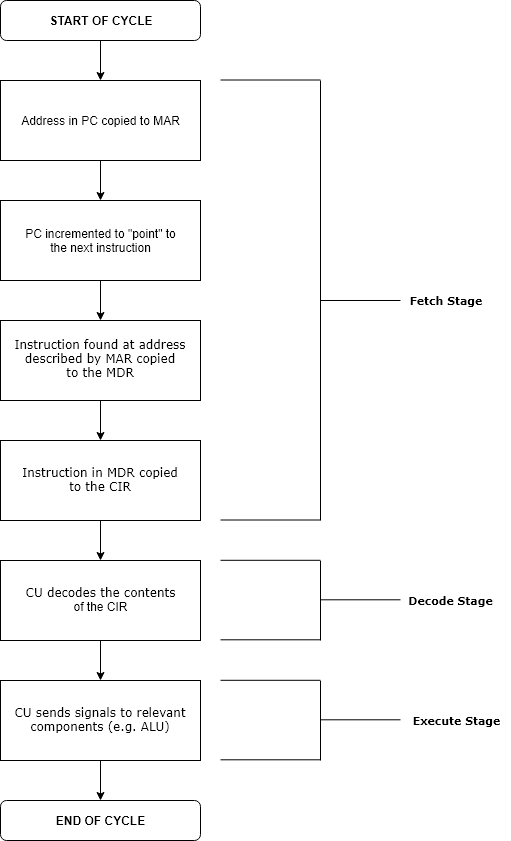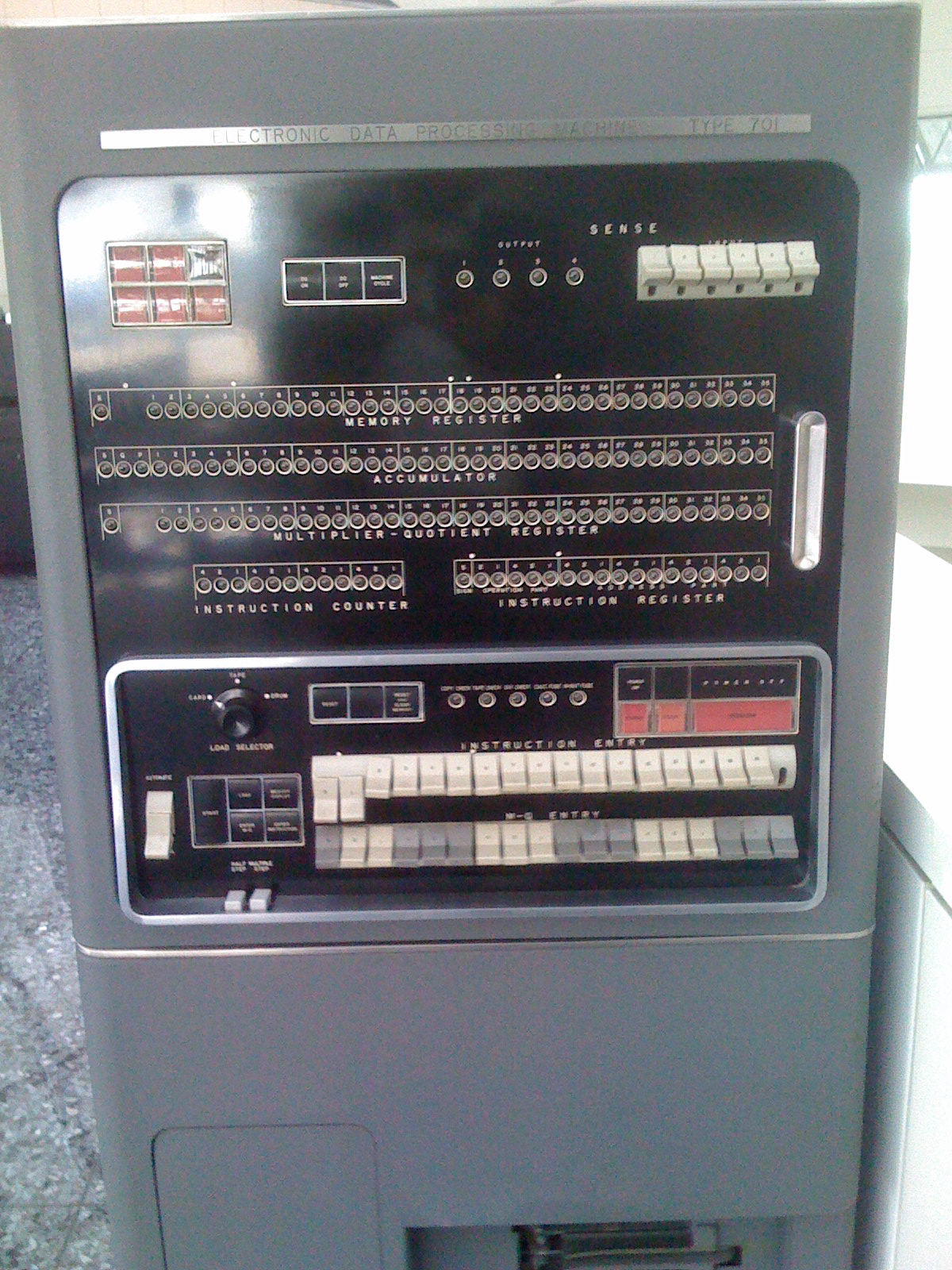|
Instruction Register
In computing, the instruction register (IR) or current instruction register (CIR) is the part of a CPU's control unit that holds the instruction currently being executed or decoded. In simple processors, each instruction to be executed is loaded into the instruction register, which holds it while it is decoded, prepared and ultimately executed, which can take several steps. Some of the complicated processors use a pipeline of instruction registers where each stage of the pipeline does part of the decoding, preparation or execution and then passes it to the next stage for its step. Modern processors can even do some of the steps out of order as decoding on several instructions is done in parallel. Decoding the op-code in the instruction register includes determining the instruction, determining where its operands are in memory, retrieving the operands from memory, allocating processor resources to execute the command (in super scalar processors), etc. The output of the IR is ... [...More Info...] [...Related Items...] OR: [Wikipedia] [Google] [Baidu] |
Computing
Computing is any goal-oriented activity requiring, benefiting from, or creating computer, computing machinery. It includes the study and experimentation of algorithmic processes, and the development of both computer hardware, hardware and software. Computing has scientific, engineering, mathematical, technological, and social aspects. Major computing disciplines include computer engineering, computer science, cybersecurity, data science, information systems, information technology, and software engineering. The term ''computing'' is also synonymous with counting and calculation, calculating. In earlier times, it was used in reference to the action performed by Mechanical computer, mechanical computing machines, and before that, to Computer (occupation), human computers. History The history of computing is longer than the history of computing hardware and includes the history of methods intended for pen and paper (or for chalk and slate) with or without the aid of tables. ... [...More Info...] [...Related Items...] OR: [Wikipedia] [Google] [Baidu] |
Central Processing Unit
A central processing unit (CPU), also called a central processor, main processor, or just processor, is the primary Processor (computing), processor in a given computer. Its electronic circuitry executes Instruction (computing), instructions of a computer program, such as arithmetic, logic, controlling, and input/output (I/O) operations. This role contrasts with that of external components, such as main memory and I/O circuitry, and specialized coprocessors such as graphics processing units (GPUs). The form, CPU design, design, and implementation of CPUs have changed over time, but their fundamental operation remains almost unchanged. Principal components of a CPU include the arithmetic–logic unit (ALU) that performs arithmetic operation, arithmetic and Bitwise operation, logic operations, processor registers that supply operands to the ALU and store the results of ALU operations, and a control unit that orchestrates the #Fetch, fetching (from memory), #Decode, decoding and ... [...More Info...] [...Related Items...] OR: [Wikipedia] [Google] [Baidu] |
Control Unit
The control unit (CU) is a component of a computer's central processing unit (CPU) that directs the operation of the processor. A CU typically uses a binary decoder to convert coded instructions into timing and control signals that direct the operation of the other units (memory, arithmetic logic unit and input and output devices, etc.). Most computer resources are managed by the CU. It directs the flow of data between the CPU and the other devices. John von Neumann included the control unit as part of the von Neumann architecture. In modern computer designs, the control unit is typically an internal part of the CPU with its overall role and operation unchanged since its introduction. Multicycle control units The simplest computers use a multicycle microarchitecture. These were the earliest designs. They are still popular in the very smallest computers, such as the embedded systems that operate machinery. In a computer, the control unit often steps through the instructio ... [...More Info...] [...Related Items...] OR: [Wikipedia] [Google] [Baidu] |
Instruction Pipeline
In computer engineering, instruction pipelining is a technique for implementing instruction-level parallelism within a single processor. Pipelining attempts to keep every part of the processor busy with some instruction by dividing incoming Machine code, instructions into a series of sequential steps (the eponymous "Pipeline (computing), pipeline") performed by different Central processing unit#Structure and implementation, processor units with different parts of instructions processed in parallel. Concept and motivation In a pipelined computer, instructions flow through the central processing unit (CPU) in stages. For example, it might have one stage for each step of the von Neumann architecture, von Neumann cycle: Fetch the instruction, fetch the operands, do the instruction, write the results. A pipelined computer usually has "pipeline registers" after each stage. These store information from the instruction and calculations so that the logic gates of the next stage can do th ... [...More Info...] [...Related Items...] OR: [Wikipedia] [Google] [Baidu] |
Op-code
In computing, an opcode (abbreviated from operation code) is an enumerated value that specifies the operation to be performed. Opcodes are employed in hardware devices such as arithmetic logic units (ALUs), central processing units (CPUs), and software instruction sets. In ALUs, the opcode is directly applied to circuitry via an input signal bus. In contrast, in CPUs, the opcode is the portion of a machine language instruction that specifies the operation to be performed. CPUs Opcodes are found in the machine language instructions of CPUs as well as in some abstract computing machines. In CPUs, an opcode may be referred to as an instruction machine code, instruction code, instruction syllable, instruction parcel, or opstring. For any particular processor (which may be a general CPU or a more specialized processing unit), the opcodes are defined by the processor's instruction set architecture (ISA). They can be described using an opcode table. The types of operations may include ... [...More Info...] [...Related Items...] OR: [Wikipedia] [Google] [Baidu] |
Superscalar
A superscalar processor (or multiple-issue processor) is a CPU that implements a form of parallelism called instruction-level parallelism within a single processor. In contrast to a scalar processor, which can execute at most one single instruction per clock cycle, a superscalar processor can execute or start executing more than one instruction during a clock cycle by simultaneously dispatching multiple instructions to different execution units on the processor. It therefore allows more throughput (the number of instructions that can be executed in a unit of time which can even be less than 1) than would otherwise be possible at a given clock rate. Each execution unit is not a separate processor (or a core if the processor is a multi-core processor), but an execution resource within a single CPU such as an arithmetic logic unit. While a superscalar CPU is typically also pipelined, superscalar and pipelining execution are considered different performance enhancement techni ... [...More Info...] [...Related Items...] OR: [Wikipedia] [Google] [Baidu] |
Instruction Cycle
The instruction cycle (also known as the fetch–decode–execute cycle, or simply the fetch–execute cycle) is the cycle that the central processing unit (CPU) follows from boot-up until the computer has shut down in order to process instructions. It is composed of three main stages: the fetch stage, the decode stage, and the execute stage. In simpler CPUs, the instruction cycle is executed sequentially, each instruction being processed before the next one is started. In most modern CPUs, the instruction cycles are instead executed concurrently, and often in parallel, through an instruction pipeline: the next instruction starts being processed before the previous instruction has finished, which is possible because the cycle is broken up into separate steps. Role of components Program counter The program counter (PC) is a register that holds the memory address of the next instruction to be executed. After each instruction copy to the memory address register (MAR), the PC can ... [...More Info...] [...Related Items...] OR: [Wikipedia] [Google] [Baidu] |
Program Counter
The program counter (PC), commonly called the instruction pointer (IP) in Intel x86 and Itanium microprocessors, and sometimes called the instruction address register (IAR), the instruction counter, or just part of the instruction sequencer, is a processor register that indicates where a computer is in its program sequence. Usually, the PC is incremented after fetching an instruction, and holds the memory address of (" points to") the next instruction that would be executed. Processors usually fetch instructions sequentially from memory, but ''control transfer'' instructions change the sequence by placing a new value in the PC. These include branches (sometimes called jumps), subroutine calls, and returns. A transfer that is conditional on the truth of some assertion lets the computer follow a different sequence under different conditions. A branch provides that the next instruction is fetched from elsewhere in memory. A subroutine call not only branches but saves the ... [...More Info...] [...Related Items...] OR: [Wikipedia] [Google] [Baidu] |




